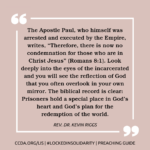A client at the shelter where I serve has trouble walking due to a work accident. If it were up to him, he would sit in his wheelchair all day because walking is a painful challenge. For some time, every day was a battle between him and I—me, prodding him to exercise with his walker; him, refusing to do much of anything. Then one day, giving him a pen and a piece of paper, I asked him to draw the situation in which he would like to be. Unsurprisingly, the young man drew himself walking again. I asked how he planned to reach this goal and he reluctantly admitted that he would have to attend physical therapy and exercise regularly. Since then, he is always on-time for his therapy appointments and much more willing to use his walker when encouraged to do so.
This story is a small and simple example of how art both substantiates people’s realities and connects them to their possibilities. But what is art?
Lyndell Backues, who has worked as a community development practitioner in Indonesia for almost 20 years, calls art “subject matter incarnate.”
“By its very nature it must be representative of a deeper reality,” he says.
That is, the role of art is to point to something else, something more significant than the artwork itself. For the young man in this story, his artwork clarified what he wanted, forced him to reflect on his present situation and drove him to make the changes necessary to achieve his goal of mobility.
Readers of Proverbs 29:18 are told that “where there is no vision, the people perish.” Communities need to define their goals in order to progress in fulfilling them. And what vision should the Christian Community Development worker encourage?
Jesus spent his entire ministry focused on the coming Kingdom of God and so should development workers in their support of community art. The beauty, justice, mystery, subversion, and dependence on God that Christians find in Jesus’ accounts of the Kingdom are lavish resources, especially for communities that lack hope and vision. When the artistic endeavors of a community point to God’s perfect future, the communal imagination is re-ignited. That spark leads to sincere reflection and, therefore, fuel for action.
No creative activity aimed at communal change is authentic or worthwhile unless there is true participation from the community, though. The artwork alone does not have the power to develop communities into more accurate images of the Kingdom of God. In order for true change to occur, communities must participate in their own transformation. Participation is the essential element of community development. It is important to ask constantly, “Who is participating?” “Are we participating in their lives or are they participating in our projects?” “How are we involving the marginalized?”
The facilitation of creative programming by development workers must not dictate the form and content of community art. In this way, workers may avoid the pitfall of professionalism, in which they assume that they know what a community needs. Development workers must hold the doors open for local voices and local knowledge so that locals are in control of their own advocacy efforts.
Still, while not limiting the community’s expression, development workers should suggest the Kingdom of God as the starting point for community art.
The most important aspect of imagining God’s flawless future is that it presses us to recognize the inadequacies of the present. This process of transcending ignorance to become aware of one’s own situation is called “conscientization.” Art can point out oppression, exclusion and vulnerability that would otherwise remain hidden in silence. And Kingdom-focused art cannot help but demonstrate that a community’s gloomy present is not its only option. Kingdom-focused art forces the artists and encourages the audience—which, again, must encompass the entire community—to visualize positive alternatives to the status quo. This is requisite to positive change; and God himself, his work in the world thus far and his coming glory are more-than-sufficient raw materials for envisioning better options.
Recognizing current realities and future possibilities can challenge the present, pointing out the tension between what is and what should be. For those who benefit from the status quo, change is dangerous; however, the Christian’s place is always with “the least of these” whom Jesus identifies with (see Matthew 25:31-46). When communities are oppressed, their creative faculties are among the first things to be stifled, but re-animating these faculties can lead residents to resist present injustices in profound ways. Art offers downcast communities the potential to confront the structures, institutions, standards and symbols of the powerful. Backues rightly says, “[artistic ability] just might give those most marginalized the power to identify, describe, and discard that which controls them.”
The Kingdom of God is by far the most constructive vision that the development worker can employ. Song, drama, dance, literature, painting, film, and a myriad of other art forms available to communities may serve, if guided by this vision, to exhibit possibilities, realities, and pathways between God’s Kingdom and communities’ current situations. To communities—especially ones that are oppressed, marginalized and vulnerable—these prospects offer a re-engagement of the communal imagination. They pose the question, “what will the world be like when the Kingdom of God arrives in fullness and, based on that vision, what should the world and our community be like now?” This Kingdom-based inspiration should be employed in community development work via creative activities as a means of conscientization, self-advocacy and subversion for and by the “least of these,” to whom our savior makes us accountable.
Brian Campbell works in North Philadelphia as a youth advisor at Covenant House, a shelter and service center for young people in crisis.sacredside@gmail.com.

